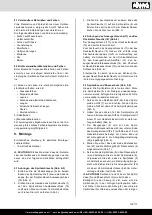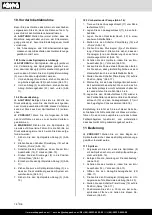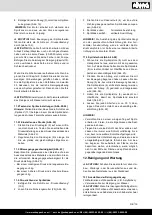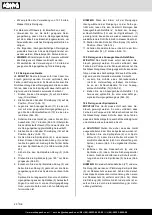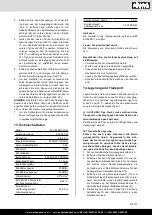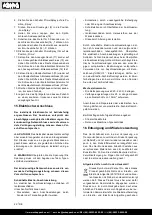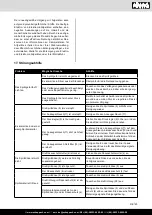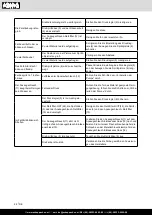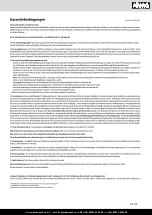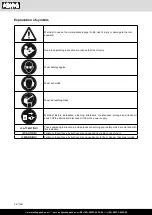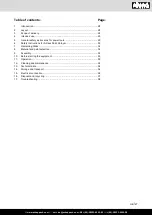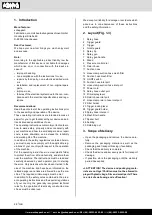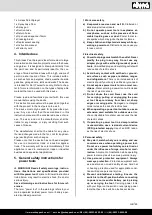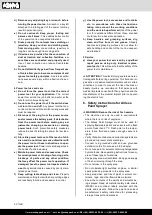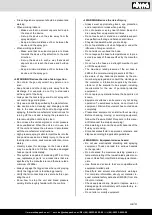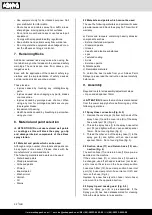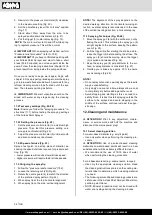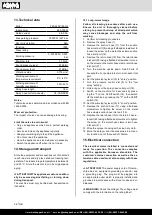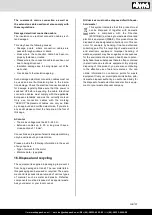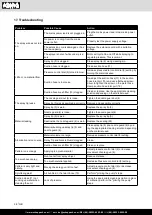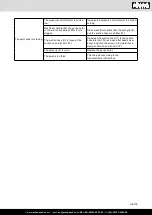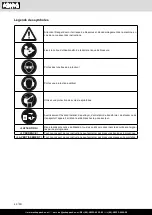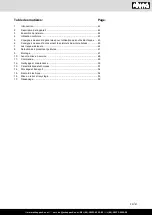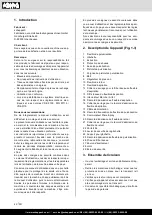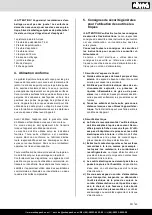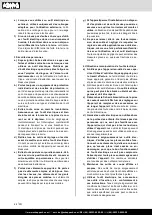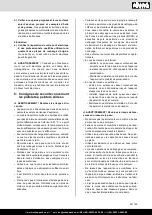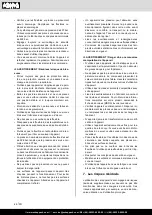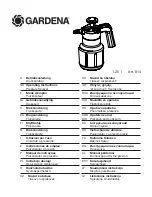
www.scheppach.com /
service@scheppach.com /
+(49)-08223-4002-99 /
+(49)-08223-4002-58
GB | 31
m
WARNING-Reduce the risk of injury
• Always wear appropriate gloves, eye protection,
and a respirator or mask when painting.
• Do not operate or spray near children. Keep chil-
dren away from equipment at all times.
• Do not overreach or stand on an unstable support.
Keep effective footing and balance at all times.
• Stay alert and watch what you are doing.
• Do not operate the unit when fatigued or under the
influence of drugs or alcohol.
• Do not kink or over-bend the hose.
• Do not expose the hose to temperatures or to pres-
sures in excess of those specified by the manufac
-
turer.
• Do not use the hose as a strength member to pull
or lift the equipment.
• The maximum rated pressure of the air hose is
228bar, the normal working pressure is 207bar.
• Be aware of any hazards presented by the ma-
terial being sprayed and consult the markings on
the container or information supplied by the man-
ufacturer of the material to be sprayed, including
requirements for the use of personal protective
equipment.
• Do not spray any material where the hazard is not
known.
• Equipment surfaces can become very hot during
operation. To avoid severe burns, do not touch hot
equipment. Wait until equipment has cooled down
completely.
• Pressurized equipment can start without warning.
Before checking, moving, or servicing equipment,
follow the Pressure Relief Procedure in this manu-
al. Disconnect the mains power plug!
•
Read warnings to know the specific hazards of the
fluids you are using.
•
Store hazardous fluid in approved containers, and
dispose according to applicable guidelines.
m
WARNING - Equipment misuse hazard
• Do not use electrostatic atomizing and spraying
equipment. These can lead to a serious hazards
to the operator.
• Do not exceed the maximum working pressure or
temperature rating of the lowest rated system com-
ponent. Read Technical Data in all equipment man-
uals.
•
Use fluids and solvents that are compatible with
equipment wetted parts.
•
Read fluid and solvent manufacturer’s warnings.
For complete information about your material, re-
quest material safety data sheet (MSDS) from dis-
tributor or retailer.
• Check equipment daily. Repair or replace worn or
damaged parts immediately with manufactory re-
placement parts only.
• Do not alter or modify equipment.
• Fire extinguisher equipment should be present and
working.
• When working indoors:
– Make sure that no solvent vapours build up in
the area of the device.
– Set up the device on the side away from the
sprayed object.
– Keep a minimum distance of 5 m between the
device and the spray gun.
• When working outdoors:
– Make sure that no solvent vapours are blown
towards the device. Pay attention to the wind
direction.
– Set up the device in such a way that solvent
vapours do not reach the device and build up
there.
– Keep a minimum distance of 5 m between the
device and the spray gun.
m
WARNING! Reduce the risk of skin injection
• Do not aim the gun at yourself, any person or an-
imal.
• Keep hands and other body parts away from the
discharge. For example, do not try to stop leaks
with any part of the body.
• Always use the nozzle tip guard. Do not spray with-
out nozzle tip guard in place.
•
Only use a nozzle tip specified by the manufacturer.
• Use caution when cleaning and changing nozzle
tips. In the case where the nozzle tip clogs while
spraying, follow the manufacturer’s instructions for
turning off the unit and relieving the pressure be
-
fore removing the nozzle tip to clean.
• Do not leave the unit energized or under pressure
while unattended. When the unit is not in use, turn
off the unit and relieve the pressure in accordance
with the manufacturer’s instructions.
• High-pressure spray is able to inject toxins into the
body and cause serious bodily injury. In the event
that injection occurs, seek medical attention imme-
diately.
• Visually inspect for damage on the hoses which
may be subjected to friction. Replace damaged
hoses or parts immediately.
• This system is capable of producing 207 bar. Only
use replacement parts or accessories that are
specified by the manufacturer and that are rated a
minimum of 228bar.
• Always engage the trigger lock when not spraying.
Verify the trigger lock is functioning properly.
• Verify that all connections are secure before oper-
ating the unit.
• Know how to stop the unit and bleed pressure
quickly. Be thoroughly familiar with the controls.

